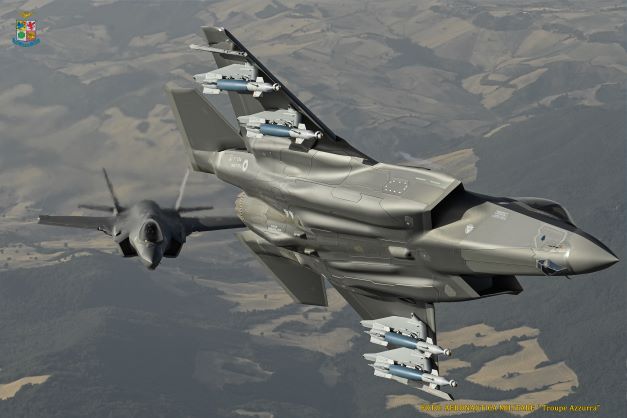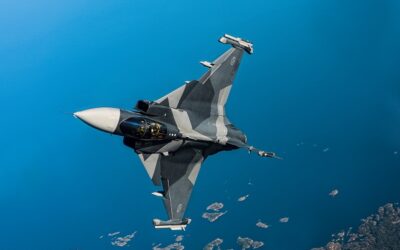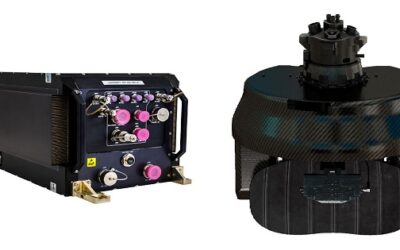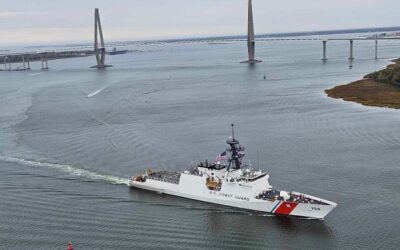Omni-Role, Multi-Mission Sensor Fusion Platform
One of the main discussion points at ILA 2022 was the Bundeswehr’s recent decision to procure Lockheed Martin’s 5th-generation combat aircraft, the F-35, to replace its remaining Tornados. Major drivers in the selection process were to ensure ‘Nationale Teilhabe’ (national participation) and the capability to deploy nuclear weapons. Nevertheless, for Germany, the decision involves the induction of a brand-new aircraft type.
Italy was one of the earliest European nations to select the F-35, ordering 131 aircraft (109 F-35A and 22 F-35B) and receiving the first in 2015. In addition, Cameri is the only production site for the aircraft outside the US. Show Daily had the opportunity to speak at length with Col Luca G Vitaliti on Italy’s experience with the aircraft and how it might be able to help Germany introduce it. He is Head of the F-35 Management, Sustainment and Integration Office, responsible for the in-servicing and implementation of new-generation capabilities, definition of operational needs and requirements, strategic planning and management of site activation, coordination of Operational Test and Evaluation activities and international cooperation in all these domains.
[The extensive interview with Col Vitaliti will be split into two sections, appearing on MON on 25 and 26 June – Editor]
SD: Can you expand on the missions and tasks the F-35 fulfils for Italy, please?
Vitaliti: Italy has played and will play a relevant role in the growth of the F-35 5th-generation capability among users. In fact, among the partners of the F-35 programme, Italy has collected several ‘first time’ events: in 2015, Italy delivered the first F-35 ever assembled outside the continental US, at Cameri, from the Euro-Med Regional Trivalent Hub. Italy was also the first non-US nation to activate a Main Operating Base (32nd Wing, Amendola Air Force Base in 2016). The Italian Air Force (ItAF) crossed the Atlantic for the first time for the global JSF programme, with a national air-to-air refueling event in February 2016. It was also the first service in Europe to declare Initial Operational Capability (IOC), validating the achievement during the Tactical Leadership Program (TLP) multinational exercise in Amendola in November 2018, when 5th-generation and earlier aircraft had the opportunity to demonstrate the level of integration already achieved.
Since 2018, ItAF F35s have been integrated into the National Air Defence system, and Italy was the first to employ the 5th-generation aircraft in a real NATO operation, fulfilling the Air Policing mission in Iceland in 2019. The ItAF, along with the Japanese Air Self-Defence Force, is to date a rare example of a single service using both F-35A and F-35B variants. In addition, the Italian F-35As have provided NATO Quick Reaction Alert (QRA) services since January this year.
We are now at work for the second F-35 Main Operating Base activation, at Ghedi ItAB (6th Wing) and, exploiting the relevant experience accumulated over the years and tremendous programme support, both from the industry and the US government sides, progress to plan is more than encouraging. As an example, on 16 June 2022, the emergence of the first F-35A aircraft bearing the insignia of the 6th Wing, entirely managed and supported by Ghedi Air Force Base personnel.
The F-35 is a 5th-generation omni-role tactical aircraft system, designed to successfully face the most challenging present and future scenarios. It can simultaneously carry out all tactical mission roles, fully integrated into a multi-domain mission environment.
It is equipped with a spectrum of capabilities that ensure strategic superiority in operations. State-of-the-art technology applied to high-performance on-board sensors, sensor fusion, low observability and net-centricity are distinctive elements. They support an exponential increase in operational effectiveness, as well as exceptional levels of survivability against dense, advanced, and synchronised threats that only the F-35 can identify and engage with precision and extreme accuracy, ensuring a high level of awareness of the tactical scenario that can be shared, to support the forces and decision-makers. Net-centricity, with the ability to acquire and exchange essential information, is key, because, progressively, freedom of movement and the possibility of access to the area of operations will be precluded for other air platforms, land vehicles and ships by increasingly effective defences.
Moreover, new concepts inspire development of appropriate logistical support and maintenance. The global pooling of logistic support and spare parts management allows, through an artificial intelligence-powered info-logistics system, prior estimation of the need for maintenance on the basis of statistical analysis and surveys. The application of this concept minimises the need to stock spare parts in the warehouses, and supports maximum efficiency on the flight line. It follows that spare parts are always available on a global scale, and delivered ‘just in time’. Furthermore, the concept of ‘follow on development’ ensures the continuation of aircraft system operational capability development after initial production, for the entire life cycle of the machine, predictably up to fifty years. In this way, operational effectiveness is assured, despite increasing and ever-changing threat scenarios.
SD: Italy was also a Tornado operator. What are the principal advantages of the F-35 – other than stealth technology – when comparing the two aircraft?
Vitaliti: The comparison between Tornado and F-35 is evidently inclement, even though the Tornado is still a multi-role combat aircraft with important capabilities in its tactical roles. In fact, between the two aircraft systems there is a gap of two generations. In addition, the F-35 is surely a unique weapon system, capable of achieving air supremacy over current and future air and ground threats. This superiority can be found in every aspect of the platform: flight characteristics, avionics, quality of embedded sensors, span, width and RF spectrum, self-protection, communications and datalink, and sustainability. Compared to the Tornado, the F-35 offers a quantum leap in terms of effectiveness, survivability and sustainability. The F-35 is superior in every respect.
The JSF has low radar and thermal signatures. Low observability allows the execution of high-risk missions, to penetrate deeply into an Area of Operations, neutralising threats well before they become a factor for the F-35 and for friendly forces in a multi-domain environment. Low observability contributes to reducing risks, increasing survivability and effectiveness for the F-35 and for the whole force package. The F-35, from this perspective, is a strategic system.
The F-35 is an omni-role combat aircraft with its operational capability based on sensor fusion. The Tornado can normally conduct one, maximum two tactical roles within the same mission. To be able to do that it needs to be prepared and configured before the mission, often with dedicated external stores. The crew is trained and qualified for specific tactical missions. As a simplified example from my own experience, we could say that in flight, in most complex air operations, 60% of crew attention is dedicated to overlay, fuse and filter data and information coming from onboard independent sensors and instrumentation, with an additional 30% of crew cognitive resources used to integrate situational awareness with information and perceptions from human senses – primarily visual, auditory and physical. This means that some 90% of total effort is required for ‘observation and orientation,’ with the residual 10% available for the ‘decide and act’ aspect of mission fulfillment in the specific tactical role assigned. This gives a rough idea of crew workload in building adequate situational awareness, and of how reaction time is thus reduced for crews of Tornado and previous generation tactical aircraft.
The JSF is natively omni-role. It does not need to be specifically configured for the mission, except for the weapon load. The tactical role changes in flight depending on mission tasks, situations/mission phases, or arising contingencies. The capacity of the aircraft, in fact, allows it to carry out multiple roles, allowing a more agile, flexible employment within the same mission, in which it can always ensure mission tasks such as air superiority, strategic reconnaissance, data collection and high precision or surgical engagement of targets. The pilot is trained, qualified, and prepared to face the whole span of tactical missions and needs to be always ready to understand when the situation requires to switch tactical role. The F-35 is powered by artificial intelligence that allows it to process, overlay, and fuse the radar air picture, data and information acquired by sensors, communication suites and datalink, and to present the whole package in a recognized, comprehensive picture. Therefore, the pilot can reduce to less than 40% the effort to properly ‘observe and orient,’ and can have over 60% of his or her cognitive resources to dedicate to the ‘decide and act’ function, a fundamental requirement to face and manage the more and more complex and challenging tactical scenarios of today’s and tomorrow’s battlespace.
Its advanced net-centric capabilities make the F-35 intrinsically multi-domain, and a fundamental data source to reconstruct and share a strategic and tactical air and surface recognized picture. Regarding fleet management and logistic support, among JSF partners and users the commonalities between the different versions of F-35 and the level of standardisation are so high that, theoretically, it will soon be possible to deploy the aircraft to other F-35 bases with either limited or no organic maintenance and support personnel.

























